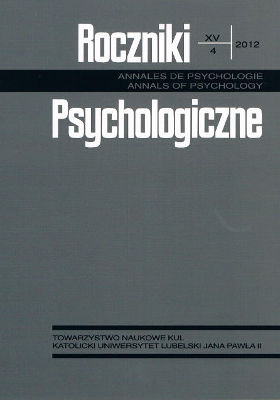The functioning of the theory of mind in blind children
Abstract
This study explored the development of a theory of mind in blind children aged between 7 and 14 years. Four tasks were administered. Two of them assessed the understanding of false beliefs: deceptive container test and changed location test; the other two assessed the perspective-taking ability with regard to well-known and unknown objects. Older blind children performed better than younger students in false belief tasks and in the perspective-taking task with regard to well-known objects. Moreover, blind children had less difficulty with understanding other people’s beliefs than with understanding their perspective, but only when understanding the perspective concerned an unknown abstract object.
References
Białecka-Pikul, M. (2002). Co dzieci wiedzą o umyśle i myśleniu. Badania i opis dziecięcej reprezentacji stanów mentalnych. Kraków: Wydawnictwo Uniwersytetu Jagiellońskiego.
Białecka-Pikul, M. (2004). Nabywanie wiedzy społecznej z perspektywy badań nad dziecięcymi teoriami umysłu. Przegląd Psychologiczny, 47, 3, 305-317.
Bigelow, A. (1988). Blind children’s concepts of how people see. Journal of Visual Impairment & Blindness, 82, 2, 65-68.
Bishop, M., Hobson, R. P., Lee, A. (2005). Symbolic play in congenitally blind children. Development and Psychopathology, 17, 2, 447-465.
Brambring, M. (2005). Perceptual perspective taking in children who are blind: The state of research and a single-case study. British Journal of Visual Impairment, 23, 3, 122-127.
Chlewiński, Z. (1999). Umysł. Dynamiczna organizacja pojęć. Analiza psychologiczna. Warszawa: Wydawnictwo Naukowe PWN.
Doherty, M. J. (2009). Theory of mind. How children undestand others’ thoughts and feelings. Hove–New York: Psychology Press.
Farrenkopf, C., Davidson, I. F. (1992). The development of perspective-taking abilities in young blind children. RE:view, 24, 1, 7-22.
Ferguson, R., Buultjens, M. (1995). The play behaviour of young blind children and its relationship to developmental stages. British Journal of Visual Impairment, 13, 3, 100-107.
Flavell, J. H., Everett, B. A., Croft, K., Flavell, E. R. (1981). Young children’s knowledge about perception: Further evidence for the Level 1 – Level 2 distinction. Developmental Psychology, 17, 1, 99-103.
Flavell, J. H., Miller, P. H., Miller, S. A. (1993). Cognitive development. Englewood Cliffs, NJ: Prentice Hall, Inc.
Green, S., Pring, L., Swettenham, J. (2004). An investigation of first-order false belief understanding of children with congenital profound visual impairment. British Journal of Developmental Psychology, 22, 1, 1-17.
Kielar-Turska, M. (2000). Rozwój człowieka w pełnym cyklu życia. W: J. Strelau (red.), Psychologia. Podręcznik akademicki, t. 1: Podstawy psychologii (s. 285-332). Gdańsk: GWP.
Kołodziejczyk, A. (2003). Dziecięca koncepcja fikcji, czyli co jest „na niby” w telewizji. Kraków: Wydawnictwo Uniwersytetu Jagiellońskiego.
McAlpine, L. M., Moore, C. L. (1995). The development of social understanding in children with visual impairments. Journal of Visual Impairment and Blindness, 89, 4, 349-358.
Miletic, G. (1994). Vibrotactile perception: Perspective taking by children who are visually impaired. Journal of Visual Impairment & Blindness, 88, 6, 550-563.
Miletic, G. (1995). Perspective taking: Knowledge of Level 1 and Level 2 rules by congenitally blind, low vision, and sighted children. Journal of Visual Impairment & Blindness, 89, 6, 514-523.
Minter, M., Hobson, R. P., Bishop, M. (1998). Congenital visual impairment and “theory of mind”. British Journal of Developmental Psychology, 16, 2, 183-196.
Peterson, C. C., Peterson, J. L., Webb, J. (2000). Factors influencing the development of a theory of mind in blind children. British Journal of Developmental Psychology, 18, 3, 431-447.
Premack, D., Woodruff, G. (1978). Does the chimpanzee have a theory of mind? Behavioral and Brain Sciences, 1, 515-526.
Roch-Levecq, A.-C. (2006). Production of basic emotions by children with congenital blindness: Evidence for the embodiment of theory of mind. British Journal of Developmental Psychology, 24, 3, 507-528.
Szubielska, M. (2010). Zdolności wyobrażeniowe niewidomych dzieci w zakresie skaningu i rotacji kształtu dotykanych obiektów. Roczniki Psychologiczne, 13, 2, 145-160.
Warren, D. H. (1994). Blindness and children. An individual differences approach. Cambridge: Cambridge University Press.
Watemberg, J., Cermak, S., Henderson, A. (1986). Right-left discrimination in blind and sighted children. Physical & Occupational Therapy in Pediatrics, 6, 1, 7-19.
Wimmer, H., Perner, J. (1983). Beliefs about beliefs: Representation and constraining function of wrong beliefs in young children’s understanding of deception. Cognition, 13, 103-128.
Copyright (c) 2012 Roczniki Psychologiczne

This work is licensed under a Creative Commons Attribution-NonCommercial-NoDerivatives 4.0 International License.


